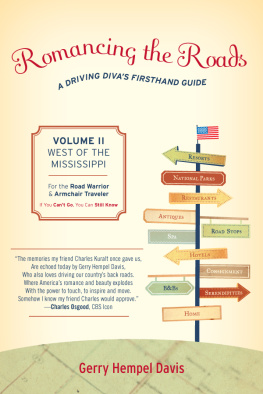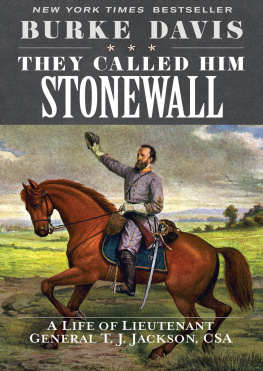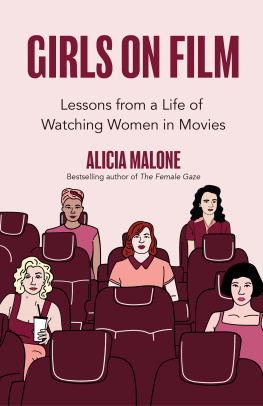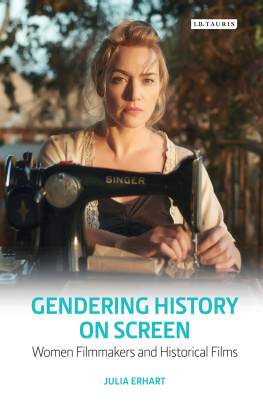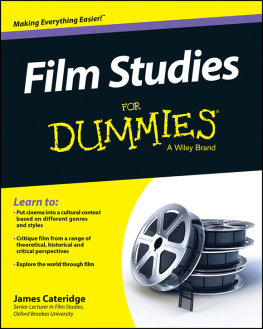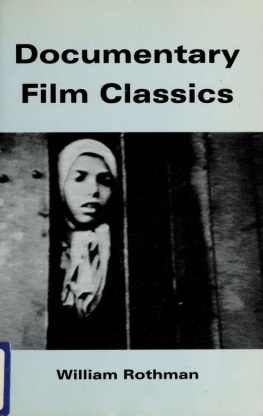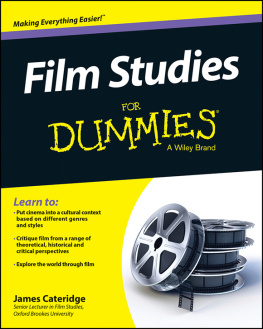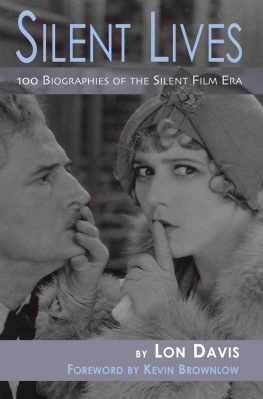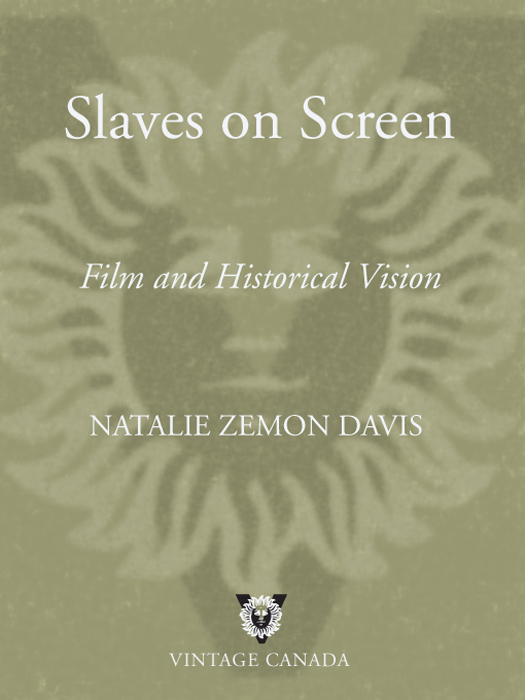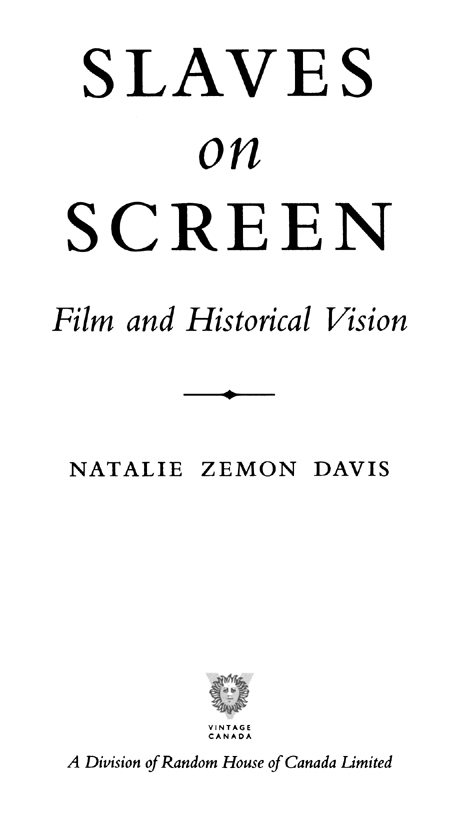2000 by Natalie Zemon Davis
All rights reserved under International and Pan American Copyright Conventions. No part of this book may be reproduced in any form or by any electronic or mechanical means, including information storage and retrieval systems, without permission in writing from the publisher, except by a reviewer, who may quote brief passages in a review.
First published in Canada by Vintage Canada, a Division of Random House of Canada Limited.
Vintage Canada and colophon are registered trademarks of Random House of Canada Limited.
Canadian Cataloguing in Data Publication
Davis, Natalie Zemon
Slaves on screen
(The Barbara Frum lectureship)
eISBN: 978-0-307-36885-0
1. Historical films - History and criticism. 2. Slavery in motion pictures. I. Title. II. Series: The Barbara Frum lecture series.
PN 1995.9. H 5 D 38 2000 79 I .43658 C 99-93200-0
Cover image: Ivory bust, Nora August, 1865. Sea Island Company, Sea Island, Georgia. Photograph of the bust courtesy of the Museum of the Confederacy, Richmond, Virginia.
Photography by Katherine Wetzel.
See for illustration credits.
v3.1
To the memory of
Julian Leon Zemon
19021984
and
Horace Bancroft Davis
18981999
CONTENTS
CHAPTER ONE
Film as Historical Narrative
CHAPTER TWO
Resistance and Survival: Spartacus
CHAPTER THREE
Ceremony and Revolt: Burn! and The Last Supper
CHAPTER FOUR
Witnesses of Trauma: Amistad and Beloved
CHAPTER FIVE
Telling the Truth
Preface
T HE THEMES of Slaves on Screen have been entwined in my life for years. When I started my graduate studies a half-century ago, I planned to put my history training to work in documentary film. But then I was caught by voices from the archives and books of the distant past, especially the voices of resistance: of a fifteenth-century lady writer informing her malicious male critics that women had invented new arts and sciences; of Protestants marching through the streets of sixteenth-century Lyon singing the Psalms in French, in defiance of the Catholic clergy; of printers journeymen striking for higher wages and claiming, as honorable workers, the right to sit at their masters tables. I put aside my movie plans and turned instead to the typewriter, the printing press, and the university podium.
In my decades as a historian, I have concentrated on people somehow outside the traditional centers of power or wealth in the early modern period: artisans and their wives, the urban poor, peasant families, women writers and women religious activists, and, most recently, American Indians in New France and Africans living as slaves in the Caribbean and Suriname. In all these cases, I have seen the people not as personifications of heroism or passive victimhood. Rather, they are flesh-and-blood human beings with some agency, shaped by the distinctive circumstances and values of their times, sometimes accommodating, sometimes resisting, sometimes suffering, sometimes escaping, sometimes changing things and trying something new.
By the 1970s, I had new ideas about how to get an understanding of men and women who have usually left us little written evidence about themselvesand these ideas were to take me back to the world of film. I began to see how I could use not only folk tales, folk medicine, and proverbs in my quest, but also carnivals, charivaris (or shivarees, as we call them in North America), and other festivals as well as popular liturgical forms. This approach meant thinking of the cultures of the early modern period in terms of performance, of trying to visualize the dramatic unfolding of conflicts and solidarities in a village or city neighborhood. I yearned for a juicy example, where I could be like an anthropologist observing daily experience, rather than putting an account together from a tax record here, a marriage contract there.
At this juncture I came across a description of a 1560 trial written by the judge: a case of imposture in a Pyrenean village, where a man had taken the identity of Martin Guerre for three years or more, deceiving even his wifeor so it was said. This has got to be a film! I thought.
In 198082 I found myself serving as historical consultant to director Daniel Vigne and scenarist Jean-Claude Carrire for Le retour de Martin Guerre. Among the many fruits of working with these talented filmmakers was the chance to see history in extensive play outside the classroom, the scholarly meeting, the professional journal, and the book review. Though the director had the final say, decisions about how the past would look and sound were made in every corner, even by local villagers who decided which of their farm animals to provide. The actors found their own paths to reenacting sixteenth-century lives: some by reading the judges account or relevant books, others by talking about sensibilities and motives or posture and hand gestures in the days of Martin Guerre. Some entered their roles from the outside, by putting on sixteenth-century dress; others from the inside, starting from the gutsor so it seemed with Grard Depardieu. Watching Depardieu playing the impostor Arnaud du Thil playing Martin Guerre gave me new questions to ask about the definition of self in sixteenth-century France. It was then that I first began to think of historical film as a thought experiment. Along with the sixteenth-century records of Martin Guerres village of Artigat, I had the village where we filmeda surrogate Artigat where we could try out the past.
For me, the story of Martin Guerre finally had to be a book as well as a film. I realized early along that, as good as the film was, it was making a few important departures from the historical record. Furthermore, there were complexities in the evidence that the film, rich and nuanced though it was, could not accommodate. Writing The Return of Martin Guerre while consulting on Le retour de Martin Guerre introduced me to the differences between telling history in prose and telling history on film. That double experience also convinced me that with patience, imagination, and experimentation, historical narration through film could become both more dramatic and more faithful to the sources from the past.
This conviction was, if anything, strengthened by my seminar at Princeton University in the 1980s and 1990s, History and Film, where the students tried to design films that would be both good cinema and good history. The belief in that possibility informs this book. I take as my example films on slavery and resistance to slavery, a subject at the heart of my current research. The films in Slaves on Screen are giving me new eyes with which to look once again at the plantations, uprisings, and manumissions of Suriname.
1
Film as Historical Narrative
An encampment just outside the walls of Rome, 71 BCE . A great Roman general confronts the captured gladiator Spartacus, leader of a slave uprising that had defied Romes legions for two years. Spartacus. You are he, arent you? Spartacus does not speak. I am Marcus Licinius Crassus, says the general. You must answer when I speak to you. Spartacus says not a word. The general slaps him. Spartacus spits in the generals face.



